In the highly competitive world of XC racing, the hardtail is still very much king. Dual suspension bikes may dominate at your local trail head, but when it comes to sidling up at the start line of a World Cup round, most pros are still favouring the lighter and snappier hardtail option as their tool of choice.
Over the past decade, we’ve seen significant advancements in suspension and frame technology. Full suspension bikes have evolved into faster, lighter and more efficient machines. They’re also more durable than ever, and they’re getting better value too, making them the primary choice for your average weekend warrior. What many people forget though is that over that same period, hardtails have been evolving too.
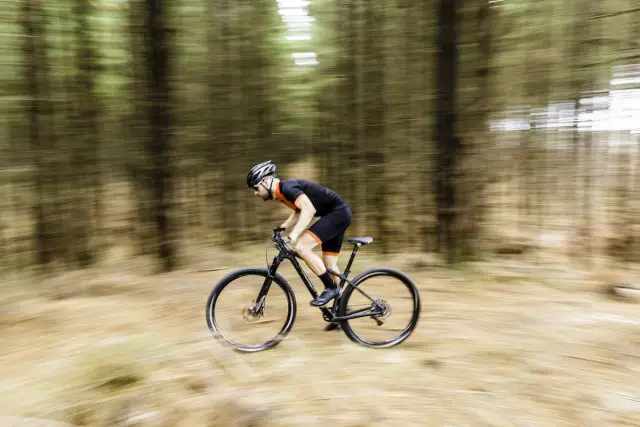
Aiming to massage all of these frame, component, and geometry innovations together into the one flagship race bike, Trek released the brand new Procaliber this time last year, replacing the outgoing Superfly. This was kind of a big deal, as the Superfly is a bike that that holds many accolades, and it’s one that really kicked off the whole carbon 29er movement back in 2007. Having been in production for nearly a decade, there’s a lot of history associated with that name.
“We wanted a new name to signify the revolution in hardtails that IsoSpeed was”, explains Travis Ott, Trek’s MTB Brand Manager, when I asked him about ditching the Superfly name. “We pulled back a legacy Gary Fisher name in the Procaliber. Procaliber was the pinnacle race bike back in the late 90s of XC racing. We wanted that same cachet.”
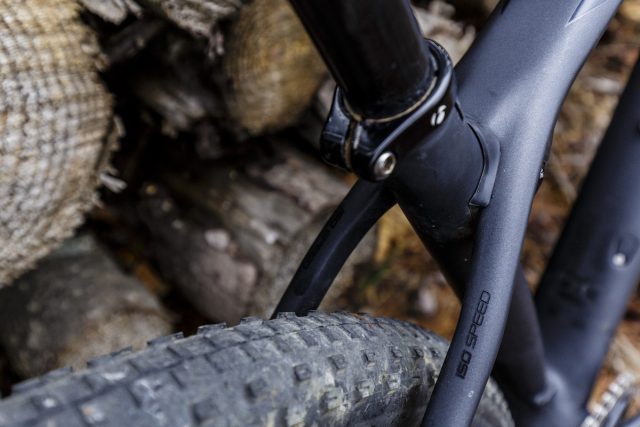
Take a closer look at the junction between the seat tube and the top tube – that’s a pivot, and that’s what Trek call IsoSpeed. Back in 2012, Trek unveiled the Domane endurance road bike that featured the same IsoSpeed pivot, or ‘decoupler’ as it’s also known. The concept behind the design is to maximize vertical compliance at the saddle, by allowing the seat post and seat tube to flex from that pivot. In essence, the pivot ‘decouples’ the seat tube from the rest of the frame. It’s an elegantly simple solution that has already been proven on the Domane, as well as the Boone cyclocross bike.
As you can imagine, the design also makes perfect sense for a mountain bike. World Cup racers are constantly searching for more comfort from their hardtails, because a more comfortable bike means less fatigue on rough racecourses. For Elite riders such as Dan McConnell who have the luxury of turning up to a race with both a dually and a hardtail in his racing arsenal, a more compliant hardtail option should make that potentially race-winning decision just a little bit easier.
So just how comfortable is the Procaliber? I’ve been riding and racing a Trek Procaliber 9.8 SL since October of last year in order to find out…
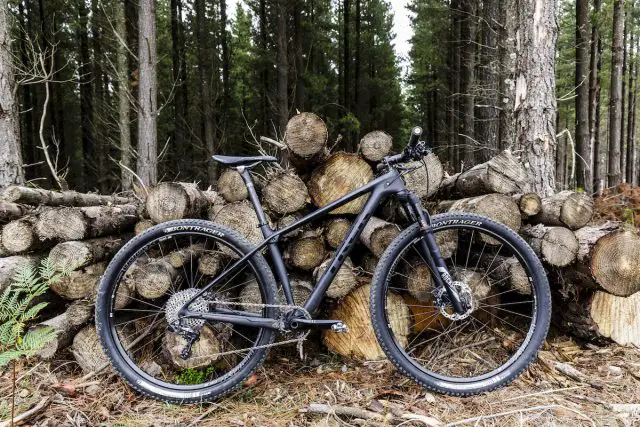
Initial Impressions
The blacked-out stealth bomber you see here is the mid-level option of the Procaliber range. Slotting between the entry-level 9.7 and the balls-out 9.9, the Procaliber 9.8 is a nicely rounded package that ticks all of the mod-con boxes. There’s a remote handlebar lockout for the RockShox SID RL fork, tubeless compatible DT Swiss wheels, and a slick 1×11 drivetrain courtesy of SRAM. All must haves for the competitive XC racer these days.
More importantly though, the Procaliber 9.8 SL shares the same frame as the more expensive 9.9 SL, which is constructed from Trek’s patented OCLV Mountain carbon fibre. Many of the tube shapes are borrowed from the outgoing Superfly SL frame, though the addition of the IsoSpeed pivot sees the Procaliber pack on a few grams. I stripped back my 17.5” test bike to the bare frame, which came in at a confirmed weight of 1130 grams – about 100 grams more than what Trek claim.
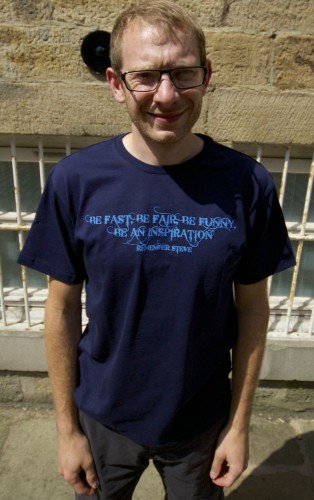
Cable routing has tidied up considerably thanks to the new Control Freak management system, which offers a plethora of internal and external routing options. Additional grommets come in the box with the bike, so you can adapt between 1x and 2/3x drivetrain setups. You can secure a Di2 battery inside the downtube, and the Procaliber’s 31.6mm seat tube will even take a dropper seatpost (Stealth or external).
Trek has moved away from their proprietary BB95 bottom bracket shell, instead using the more common PF92 standard that allows for greater compatibility with more cranks such as the RaceFace Next SL. We suspect the 92mm wide press-fit bottom bracket shell is a little cheaper to manufacture too. In the case of the Procaliber 9.8 SL, there’s a SRAM GXP press-fit bottom bracket that uses nylon cups pressed into the carbon shell. The BB itself remained solid and quiet throughout testing, though some additional grease was required between the X1 crank spindle and the non-drive bearing to silence some noise. Also bear in mind that the primary 8mm crank bolt will need checking for correct torque from time to time.
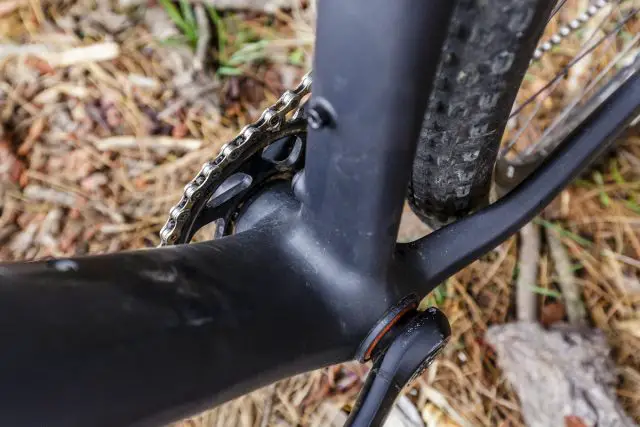
Another change for the Procaliber is the move to Boost hub spacing. First debuted on the Trek Remedy in 2014, the Boost design employs a 148mm wide rear hub and a 110mm wide front hub, which helps to increase wheel stiffness by moving the flanges further apart. For larger diameter 29in wheels with longer spokes, the difference is noticeable. The big story with Boost however, is how it offers the ability to run shorter chainstays.
In addition to the hubs, the front ‘Boosted’ chainring is also pushed 3mm outboard to maintain the correct chainline with the wider rear end. The additional real estate afforded by the offset chainring means Trek has been able to lob 10mm off the chainstay length, gifting the Procaliber a compact 435mm rear centre.
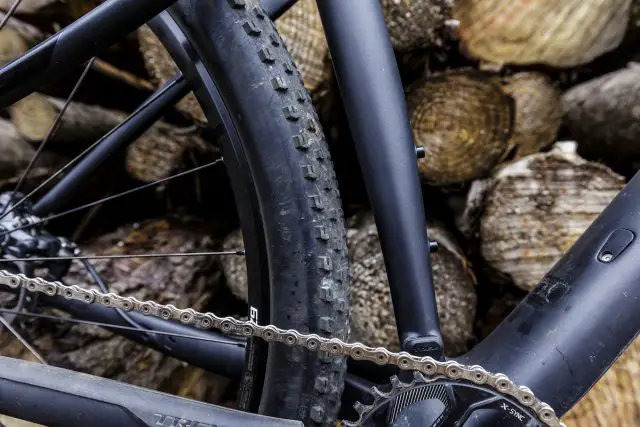
Frame geometry otherwise remains close-ish to the Superfly SL. The Procaliber’s head angle gets a little slacker at 69.5-degrees, but thanks to the longer G2 fork offset (51mm vs 46mm), the front end retains a low trail figure to keep steering crisp. The fully integrated head tube features drop-in bearings that eschew any need for additional cups, shedding a few more grams and maintaining the bikes sleek lines.
Kudos to Trek for offering up 5 frame sizes on the Procaliber, with the in-between 18.5in option offering just a little more flexibility for riders who normally borderline between a Medium (17.5in) and Large (19.5in). As with the new Top Fuel, the Procaliber goes down the Smart Wheel Size route, with the Small size (15.5in) getting smaller 27.5in wheels to maintain proper rider positioning, while the Medium and above sizes get 29in wheels. The extra sizing options must surely come with a sizeable increase in tooling and development costs, so hats off to Trek for pursuing more options.
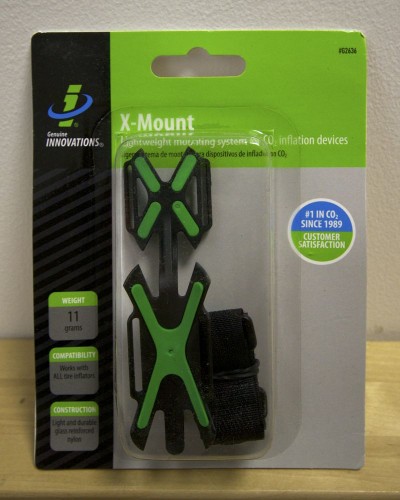
Setting up
With the rims already fitted with tubeless tape and the necessary valves included in the box, ditching the tubes is a quick and painless experience, especially with Bontrager’s excellent TLR tyres. Along with Shimano hydraulic disc brakes and just the one derailleur to adjust, the Procaliber is a very easy bike to setup. The Solo Air SID fork uses a single valve to adjust spring pressure, though I did find I needed about 10% less than what RockShox recommend on their setup guide in order to get full travel out of it.
The cockpit sits lower than the Superfly SL, thanks to a very short 90mm head tube on our Medium 17.5in test bike. This makes it easier to get the right bar height without having to resort to a stupid-negative rise stem. However, the stock handlebar is unfashionably narrow at 690mm and seems at odds with the otherwise forward-thinking geometry and frame features. Top tube lengths have grown across the board, with the Medium frame getting a decent 59.9cm ETT length that sits nicely with the 80mm long stem.
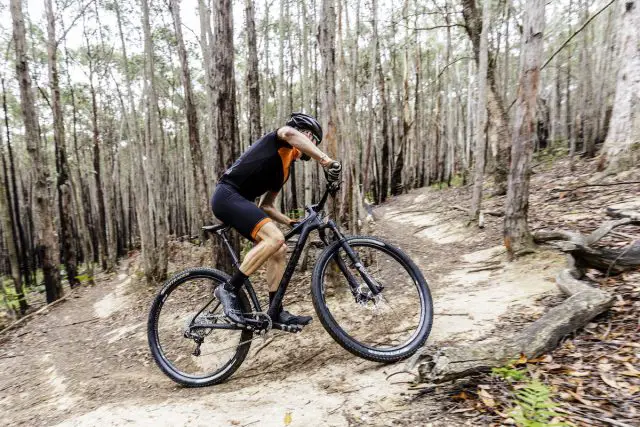
On the trail
Handlebar issues aside, the Procaliber is an easy bike to get along with on the trail. And it’s comfortable. Really comfortable.
The IsoSpeed system works exactly as advertised. It offers more compliance at the saddle, and you can visually see the seat tube flexing back and fourth as you encounter small bumps on the trail surface. Trek claim there’s 11mm of movement, with the Procaliber offering 70% more compliance than the nearest competitor. It is a subtle action however, and one that doesn’t dominate the ride. After the first 100m or so, you soon forget about the leaf spring working away underneath you.
As other reviewers have stated elsewhere, the Procaliber is still a hardtail however. Plough the bike into a rock garden, and it’ll pinball off of baby head rocks just as you’d expect a lightweight carbon frame to. The real benefit of the IsoSpeed design is that it simply mutes the high frequency vibrations and smaller impacts that would normally be felt at the saddle. This allows you to remain seated more of the time, so that you can continue laying down the power while other riders have to stand up on the pedals. It did take me several rides to recalibrate as to what impacts I could stay seated for and what impacts I still had to stand up for though, as the bigger rocks and roots will still buck you off.
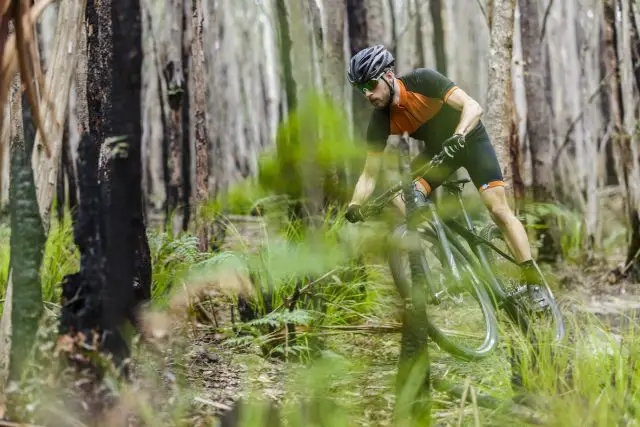
The real proof for me came from a 2-hour ride around a rock-infested test loop, where I experienced significantly less back pain riding the Procaliber than I would usually expect from a bike devoid of a rear shock. And that’s even compared to my personal steel trail hardtail bike that has big 2.35” tubeless tyres on it.
Possibly the biggest difference between the Procaliber and other hardtails though is that this vertical compliance occurs through the seat tube, and not through the seat stays. As a result, the back end feels short, stiff, and responsive under power. The Procaliber just wills you to click up the gears, hit the lockout, and get on the gas. On that note, the Procaliber is definitely a bike that rewards high speed flying. The production bike was designed with input from Trek Factory Racing’s Dan McConnell, and it shows. The Procaliber is nippy, agile and intuitive to ride – everything that many 29ers aren’t.
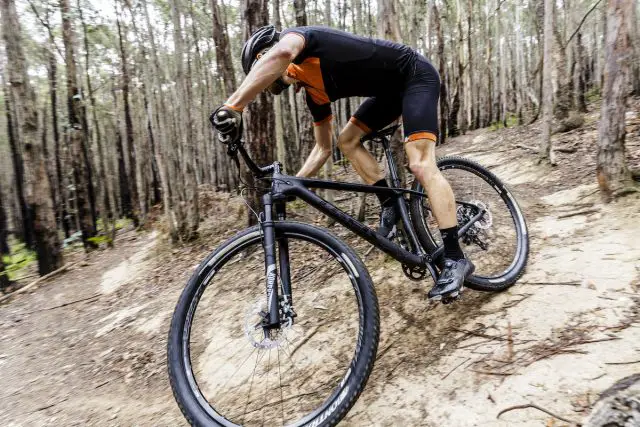
It corners with more precision than the Superfly SL, mostly because the rear wheel feels like it’s sitting directly beneath you. This is especially noticeable when facing uphill 180-degree switchbacks, where the Procaliber slices and dices its way to the top of the mountain with minimal fuss. With the shorter head tube and the lower bottom bracket height, the bike’s centre of gravity sits closer to the ground. This encourages you to stay in a low and aggressive cornering position, and really dip the handlebar down into the apex of each turn. The shorter trail figure from the G2 fork offset must also be credited for the snappy steering, though it’s the combination of geometry along with frame and wheel stiffness that make the Procaliber such a great handling bike.
That shorter and stiffer back end does offer significant handling benefits over the previous Superfly frame, but it must be said that you do feel more trail feedback through the pedals on the Procaliber. When standing up for rougher sections on a racecourse, you definitely notice the bigger hits. In that sense, the Procaliber is still very much a hardtail and shouldn’t be seen as a replacement for a full suspension race bike when facing a particularly rocky and chopped-up racecourse.
Component notes
Out of the box and setup tubeless, my 17.5in test bike tipped the scales at 9.7kg, which is a big contributing factor to the bikes rapid acceleration and eager personality. Another factor is the stiff DT Swiss wheelset. Coming in at a confirmed 1705 grams for the pair, the DT Swiss wheelset isn’t superlight, but it does ride lighter than the number suggests. This is likely due to the taut build, which features eyeleted alloy rims laced with straight-pull spokes. Combined with the thru-axles and wider Boost hub spacing, the X1700’s respond promptly to rider inputs without any hint of flex. The rims are on the narrow side by modern standards, measuring up at 19mm internally. I did find this gave a little more ‘spring’ to the 2.20in Bontrager TLR tyres though, which contributed to the overall comfort. But heavier and more aggressive riders will get more casing wobble through high-speed turns, so an upgrade to wider rims would be a worthy consideration.
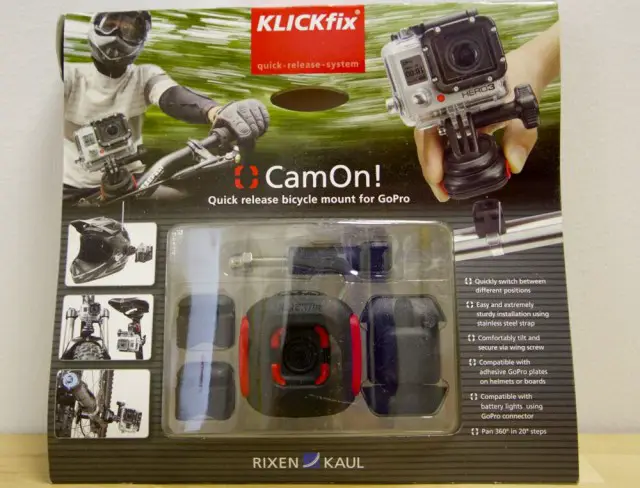
Over six months of testing, I’ve had very few complaints from the Procaliber 9.8 SL in the component department. The SRAM 1×11 drivetrain has been reliable, firing off shifts with the audible ‘clunk’ that SRAM is renowned for. Unusually for a stock bike, I was actually impressed with the ongoing shift quality of the Jagwire cable housing, which runs with full-length outer from shifter through to rear derailleur. One thing I did swap out during testing was the stock X1 cassette and chain for the top-level XX-1 equivalent. The black XG-1175 cassette shifts reasonably well, but it lacks finesse when under pressure. I noticed a substantial improvement to shift feel and speed. In comparison, the highly machined XX-1 cassette offers noticeably faster and smoother shifting, and it also produces less noise over its cheaper siblings, so it’s a worthy upgrade consideration when it comes time for replacement.
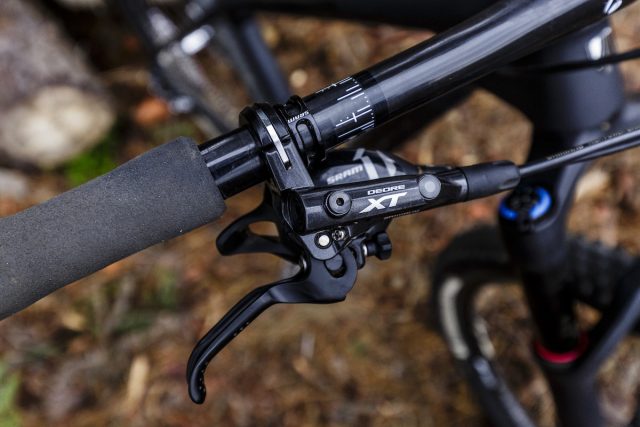
The M8000 Shimano Deore XT brakes initially gave me some trouble, with a long throw that saw the lever coming very close to the bars. Following Shimano’s advice, I ran through the full bleed procedure and also wound the Freestroke dial out a couple of turns. Apparently you should never run the brakes with the Freestroke dial wound all the way in clockwise, as this can create some inconsistencies to the braking feel once they get some heat in them. That seems like a bit of a design fault to me, so be wary if you’re playing around with your XT brakes at home. Following the recommended bleed procedure, the lever travel was reduced significantly and the XT brakes gave a much more solid feel overall.
The Bontrager cockpit is quality all-round, though I did change to a 720mm wide RXL carbon handlebar and an Evoke RXL saddle to appease my contact points and to help me get the most out of the bike’s capable handling. I didn’t have the chance, but I would have loved to have tried a dropper post too, and thanks to the 31.6mm seatpost diameter, there’s plenty of options there.
As with other RockShox forks I’ve ridden previously such as the Reba and RS1, the Procaliber’s SID exhibited a relatively firm feeling around the sag point, even with the compressions set fully open. Running lower pressure helps to smoothen up the travel, but it comes at the expense of bottoming out much more easily.
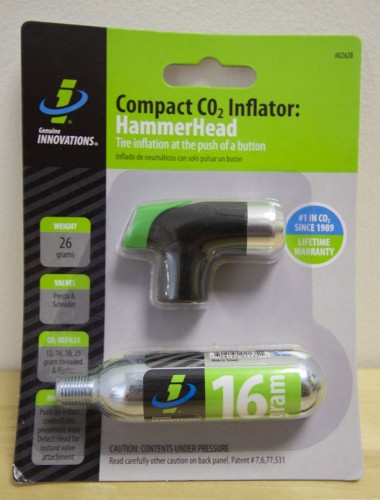
After a couple of months of riding, I stripped the forks apart and rebuilt them with fresh oil and a little bit of extra Slick Honey in the bushings and seals. This helped reduce some of the stiction I experienced initially, but I still wasn’t happy with the overall feel. In the name of science, I decided to remove the stock RL damper and its remote handlebar lockout, and swap in an RCT3 damper. Aside from tidying up the bars, the RCT3 damper does increase the small-bump sensitivity somewhat, and it also offers a much wider range of adjustment. The final piece of the puzzle was to add an extra Bottomless Token inside of the SID’s air spring. The fork comes stock with two Tokens inside, but adding a third Token allowed me to run a little more sag, while still having decent progression to avoid bottoming out.
By the end of the test period, I felt I had got as much out of the SID as I possibly could have, but it just wasn’t as supple as I wanted. That’s likely down to me just having been used to riding plusher long-travel trail forks, and the fact that the SID is a lightweight 100mm travel XC fork. In this sense, I will admit that it does suit the Procaliber well. It’s firm, stable, and it suits the aggressive attitude that this bike requires you to have in order to go fast, where you skip and glide your way over the rough stuff, rather than ploughing on through it. However, I’m keen to see how the new 2017 SID would feel on the trail, as early reports indicate it’s much plusher than the current model.
One thing to note with the IsoSpeed pivot is that like any other bolt on your bike, it will need periodic checking for tightness. That said, the pivot on our test bike has been tight, quiet and hassle-free.
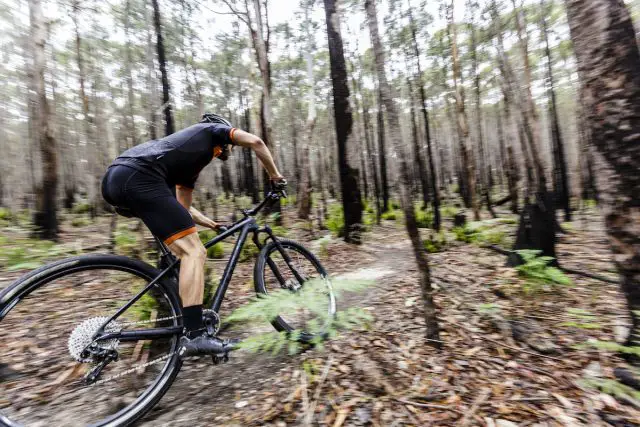
Overall
After having been mostly committed to full suspension trail bikes over the past couple of years, riding the Procaliber proved to be an eye-opening experience. It’s fast, responsive, and deadly efficient in a very addictive way, which simply cannot be matched by a full suspension bike.
It isn’t just a Formula One however. The Boost-equipped frame and fork have plenty of tyre clearance for up to 2.35” rubber, and you can easily fit a dropper post. Throw on a wide riserbar while you’re at it, and the Procaliber would make for a very fun and very whippy implement for picking apart technical singletrack. The words ‘fun’ and ‘capable’ aren’t the sorts of things that I would normally associate with an XC race hardtail, but the Procaliber most certainly is both of those and more.
Let it be said, the Procaliber is still a hardtail though, and it probably isn’t the best option if your regular trails are infested with rocks. However, it is easily the most comfortable hardtail on the market, and it’s also one of the most agile race bikes I’ve ever ridden. For the competitive XC racers out there, the Procaliber may just make the decision between hardtail and full suspension that little bit easier.
Head to TrekBikes.com for more information on the Procaliber range and to find your nearest stockist.
- Frame // Trek Procaliber OCLV Mountain Carbon Fibre
- Shock // N/A
- Fork // RockShox SID RL 100mm Remote Lockout
- Hubs // DT Swiss X1700
- Rims // DT Swiss X1700
- Tyres // Bontrager XR1 Team Issue 29×2.20in Tubeless Ready
- Chainset // SRAM X1 1400 GXP w/32t X-Sync Chainring
- Front Mech // N/A
- Rear Mech // SRAM X0-1 Type 2.1 11-Speed
- Shifters // SRAM X1 11-Speed
- Brakes // Shimano Deore XT M8000
- Stem // Bontrager RXL 80mm
- Bars // Bontrager RXL Carbon 5mm Rise 690mm Width
- Grips // ESI Chunky
- Seatpost // Bontrager XXX Carbon
- Saddle // Bontrager Montrose Elite
- Size Tested // 17.5in
- Sizes available // 15.5in, 17.5in, 18.5in, 19.5in, 21.5in
- Weight // 9.7kg
Review Info
| Brand: | Trek |
| Product: | Procaliber 9.8 SL |
| From: | www.trekbikes.com |
| Price: | £3400 |
| Tested: | by Wil Barrett for six months |
Comments (0)
Leave Reply
Post Comment
I have a Superfly ss which I love. You mention above that the boost rear end on the Procaliber allows a shorter rear centre at 435 – but this is the same as the Superfly with 142 rear?
Excellent pickup Clink!
To clarify, the Procaliber has taken 10mm off the chainstay length compared to the outgoing carbon Superfly. It has a 435mm long chainstay, compared to the 445mm on the carbon Superfly.
As you point out though, the alloy Superfly frames (including your Superfly SS) feature a 435mm chainstay length. And they achieve this with regular 142x12mm thru-axle dropouts.
However, here’s where it gets interesting: Trek measure the chainstay length as a straight line from the centre of the BB to the centre of the rear axle. This is what’s regarded as a ‘true’ chainstay measurement. Other companies out there measure the chainstay length as a horizontal line that’s parallel with the ground, with one point being the rear axle, and the other point being above where the BB lies. This is referred to as the ‘rear centre’.
Where it gets confusing in comparing those two measurements is the difference in BB height and the seat tube angle – two factors which can influence the rear centre measurement.
So while the two chainstay measurements may be the same, in real terms the Procaliber is actually shorter in the rear centre due to its lower BB.
It’s confusing, but if you jump on a Procaliber you’ll know exactly what I mean – this bike slices up tight corners like Jamie Oliver slices onions!
Nice detailed reply! My Superfly ss is ace – Procaliber must be awesome!
What a great review, I don’t know whether I prefer the bike or the write-up! A pleasure to read.
Glad you enjoyed guys 🙂
Isn’t the ‘pivot’ point likely to gather good old British grinding paste over time?
Ho! Good article! I am an XC Racer and I bought 2 weeks ago a 9.8 sl. I am very Happy of It but not much of the Sid rl ,it’s 2017 version, very stiff, but too much empty during its Travel. I add 2 tokens but It isn’t good yet. I’m interested about your update ti rct3 camper… Is It Easy to install? Do you know if is It possible ti install It in 2017 fork? Have you got the code Number? I like the pop lock ,It works very well. How is the rct3 in pedal cojfiguration? My problem is i like to have possibility ti switch by the handlebar, and I like to have the fork Locker when I pedal up. Is there a way ti have rct3 with remote ? Or something else spending similar rct3 damper? Charger damper is very expensive,maybe too much. Thank you for your time